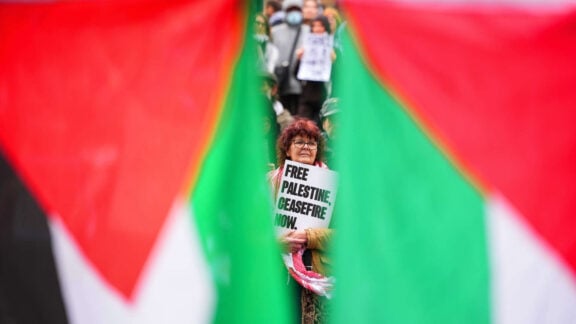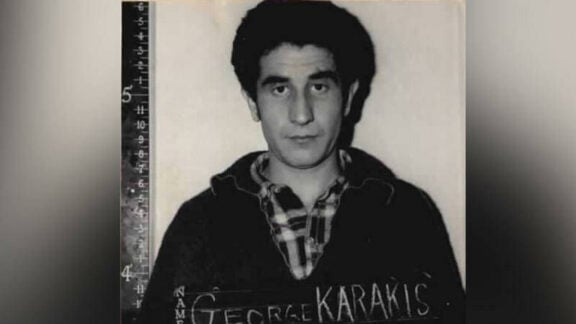Jim Claven’s new book – From Imbros Over the Sea – brings to light the important role that the island of Imbros played throughout the Gallipoli campaign in 1915 and 1916, during WW1. Notably, Jim focuses on uncovering important but little appreciated pieces of ANZAC history. This is his most recent work in his series of books documenting the Hellenic link to Anzac. It is also an accompaniment to the Imbros and Gallipoli Revealed photographic exhibition, which was first shown on June 2, 2023 by Melbourne’s Imvrian Society in Parkdale.
Jim begins by telling us about some of the mythological and historical facts of the island of Imbros. He captivates his audience by referring to its mystical ancient past that emerges out of the haze of mythology and Homer’s Illiad. Imbros survived many conquerors and Empires including the Persians, the Athenians and Alexander the Great, the Romans, the Byzantines and the Ottomans. Subsequent to five hundred years of Ottoman rule, Imbros and its overwhelmingly Hellenic population was joined to Greece in 1912.

The importance of Imbros can be highlighted through its decision to embrace thousands of military personnel – including many Australians – who arrived as part of the Gallipoli campaign. Imbros became, along with Lemnos, a very important and strategic base for the Gallipoli campaign, lying as it did so close to the Dardanelles straits and the battlefields. It was from the waters of Imbros that the Australian soldiers – having sailed from Lemnos – made their way to Anzac Cove.
The landscape of Imbros reflected the life of the local Hellenes, who were mainly farmers and fishermen, with their quiet harbour, sandy beaches, mountains and the valleys with their numerous villages surrounded by fertile fields that yielded abundant crops and sustained their lives.
However, this simple landscape underwent a transformation to accommodate the Gallipoli campaign. Infrastructure was introduced to transform the island: piers were erected that would see hundreds of ships come and go in Kephalos Bay, roads were created, buildings were constructed to house all military personnel and the press, cable systems were set up for communications, rest camps for soldiers, medical facilities were set up, along with storage depots, cemeteries built and the natural sandy flatlands became air strips for war aircraft. Jim also tells us about the establishment of the extensive Australian bakery that produced thousands of fresh bread for the soldiers at Gallipoli.
It was on Imbros that the Australian correspondent, Charles Bean and other Allied journalists would issue many of their reports of the campaign to an eager readership back home, eager for news of their loved ones. References to Imbros would also find their way into the many letters, diaries and memoirs kept by soldiers as they recounted their time on the Island. Their letters would be reproduced in Australia’s newspapers, spreading the story of Imbros across Australia. Thousands of photographs were also taken and many artists captured life on Imbros with details of topography and scenes of the island, including its many churches and townscapes, which also capture the lives of Imbros residents during the Gallipoli campaign. It is such a joy to look at Jim’s reproduction of many of these photographs and artworks in the book.
He especially describes the interaction between the troops and the local Hellenes, vividly demonstrating the positive nature of that experience. .There were locals selling their freshly caught fish from their little fishing boats to fresh fruit, fresh produce from all over the island. It was the first time that yogurt was ever tasted and British officer, the future novelist Compton Mackenzie called it ‘life giving stuff’. Donkey rides to help explore the island became a common occurrence, where locals would offer them food and invite them to their homes and villages. In effect Imbros became an oasis for soldiers and a destination that broke up the journey.

Jim book draws and is based on the archival sources of the Gallipoli campaign – the official documents, ships logs, diaries, letters and memoirs, as well as the hundreds of photographs taken by Australian and Allied personnel during their service on Imbros.
As Jim points out Imbros is one of many locations that played a major role in the Anzac story – from Lemnos, to Imbros and Tenedos and beyond. This story stretches to the Hellenic towns and settlements of the Gallipoli peninsula itself, such as the town of Krithia, from where my own heritage is sourced.
The Gallipoli campaign was primarily a military campaign and its brought war and destruction to the Hellenes of Gallipoli. Krithia was the site of major battles during the campaign, its population forced to move by the Ottoman authorities. A life stretching back centuries was disrupted and would never be the same again. The story of Krithia and its people, of the impact of war, is another story that needs to be revealed. Jim’s book and its associated exhibition has given me encouragement to further my own academic researches into these Hellenic aspects of Australia’s Gallipoli campaign.
Historical events such as these are being forgotten before they have been written down or passed on, which is what Jim has deterred from occurring by his recounts of Imbros in this book. He shines light on “the impact of the campaign on (Imbrians’) lives and that this was the beginning of the Hellenic link to Anzac, a connection that would continue to grow across both world wars and on through the migration of Hellenes in Australia”.
Jim’s recount of Imbros is a joy to read. It reveals this little appreciated but important aspect of the Gallipoli campaign, capturing the sentiments and joys, the difficulties and hardships, the relationships and life of the Hellenes and soldiers during this time. I commend Jim’s new work which – like his previous historical works – recount these often overlooked aspects of not only the Gallipoli Campaign but also these early and significant interactions of Hellenes and Australians from over one hundred years ago.
Jim Claven’s From Imbros Over The Sea is published by the Imvrians’ Society of Melbourne. Priced at $35. To order contact George Xinos – georgexinos@gmail.com or scan the QR code below.
Kris Stamboulidis is President of the Krithian Association of Australia. She has for many years been researching the history of Krithia and its Hellenic population, both in the Ottoman Empire and in Greece following the Asia Minor catastrophe as well as its part of the Hellenic Diaspora throughout the world. Kris can be contacted via email: kris@stambos.com










